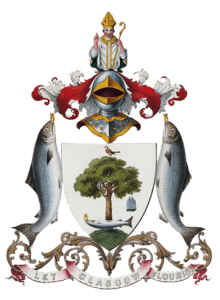Partick Thistle F.C.
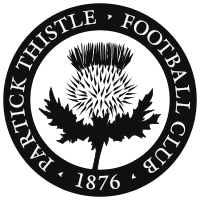 | |||
| Full name | Partick Thistle Football Club | ||
|---|---|---|---|
| Nickname(s) | The Jags, The Maryhill Magyars, The Harry Wraggs, Thistle | ||
| Founded | 1876 | ||
| Ground | Firhill Stadium, Maryhill, Glasgow | ||
| Capacity | 10,102[1] | ||
| Chairman | David Beattie | ||
| Manager | Alan Archibald | ||
| League | Scottish Premiership | ||
| 2015–16 | Scottish Premiership, 9th | ||
| Website | Club home page | ||
|
| |||
Partick Thistle Football Club (nicknamed the Jags) are a professional football club from Glasgow, Scotland. Despite their name, the club are based at Firhill Stadium in the Maryhill area of the city, and have not played in Partick since 1908. The club have been members of the Scottish Professional Football League (SPFL) since its formation in 2013 and compete in the Scottish Premiership, the highest tier of the SPFL structure, following promotion from the 2012–13 Scottish First Division. They are one of three Glasgow-based teams competing in the Premiership, the others being Celtic and Rangers, with Queen's Park playing in the Scottish League One.
Since 1936, Thistle have played in their distinctive red-and-yellow jerseys of varying designs, with hoops, stripes and predominantly yellow tops with red trims having been used, although in 2009 a centenary kit was launched in the original navy-blue style to commemorate 100 years at Firhill.[2] Since 1908 the club have won the Scottish Second Division once and the Scottish First Division (second tier, now the Scottish Championship) six times, most recently in 2013. Thistle have won the Scottish Cup and the Scottish League Cup in 1921 and 1971 respectively.
The club are managed by former defender Alan Archibald, who took over the role on 30 January 2013, following the departure of Jackie McNamara to Dundee United. Under Archibald's management, the club achieved promotion to the newly formed Scottish Premiership in 2013, and have remained there for three consecutive seasons.
History
Formation and early years
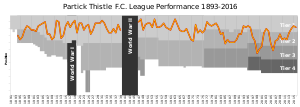
Partick Thistle Football Club was formed in 1876 in the burgh of Partick, which was at that time administratively independent of Glasgow (Partick was not subsumed into Glasgow until 1912). The club's first recorded match (and victory) took place in February against a local junior team, named Valencia.[3] The location of this match, and thereby Thistle's first home ground, was recorded as 'Overnewton Park', which is thought to have been located next to Overnewton Road, just south of Kelvingrove Park.[4] In 1891, Partick Thistle joined the Scottish Football Alliance, one of several competitions set up immediately after the formation of the Scottish Football League in 1890. The club won the Second Division championship in 1897 and were elected to the First Division. The following season they were re-elected after finishing in eighth place. In 1900 they were elected back to the top level, having finished as Second Division champions again, but were relegated the following season and then promoted in second place in 1902. This would be the last time Thistle changed their division for almost 70 years.[5] Since joining the Scottish professional leagues in 1893, Thistle had been an unpredictable side, spending four years in the First Division and five in the Second, winning promotion three times. It was during the 1902–03 Scottish Division One season in which Thistle set their highest finish in the Scottish league structure, finishing 8th in the table with 19 points.[6] In the following 33 years, they moved from home to home, using parks at Kelvingrove, Jordanvale, Muirpark, Inchview among others. In 1891 they moved to Meadowside, where they played until 1908. After being homeless for over a season, they moved to their present home, Firhill Stadium, in the Maryhill district of Glasgow. They played their first home match at Firhill, on 18 September 1909, in a 3–1 victory against Dumbarton Harp.[7]
Cup success and league progress
In 1921 Thistle won the Scottish Cup, beating Rangers 1–0 in the final.[8] Johnny Blair scored the only goal of the game, which was held at Celtic Park.[7] The Jags reached the final again nine years later, facing the same opposition, but Rangers won 2–1 in a replay following a 0–0 draw in the first match. In 1935 the Jags won both the Glasgow Cup and the Charity Cup, competitions that were taken seriously at the time.[9]
Although it was over 30 years before Thistle achieved further cup success they not only maintained their top tier status during this period but finished third in the league in 1947–48, 1953–54 and 1962–63.
On 23 October 1971 Davie McParland's team secured the club's most famous result against Jock Stein's Celtic in the League Cup final at Hampden Park, Glasgow. 62,470 fans watched Thistle take a dramatic 4–0 lead at half time with goals from Alex Rae, Bobby Lawrie and Jimmy Bone amongst the many emerging talents in the Thistle squad including Alan Rough, Alex Forsyth and Denis McQuade. Kenny Dalglish pulled a goal back for Celtic, however the final result was never in doubt as Thistle eased to a 4–1 victory. Ironically before the match, former BBC sport broadcaster Sam Leitch stated that "In Scotland, it's League Cup final day at Hampden Park, where Celtic meet Partick Thistle, who have no chance."[10]
Decline and "Save the Jags" campaign
Thistle's fortunes on the pitch declined during the 1980s. Although the club had experienced difficult times before, having dropped into the second tier of Scottish football twice in the 1970s, they had bounced straight back up on both occasions. The relegation of 1982 led to the Club's first sustained period outside the top tier since the late 19th century. Although this period of exile ended with promotion in 1992, mounting financial problems, including a debt of over £1.5 million, threatened to put the club out of existence.[11] In 1998 in particular the club was close to going bankrupt and was only kept afloat by the fan-organised "Save the Jags" campaign.[12] Despite avoiding financial oblivion Thistle were relegated to the third tier of Scottish Football in 1997–98 and only narrowly avoided a further relegation the following season, finishing in eighth place.
Revival under John Lambie
In 1999 John Lambie commenced his third period as manager of the club and under his stewardship Thistle enjoyed a brief revival, winning back-to-back promotions in 2000–01 and 2001–02, the second of which earned the club a place in the Scottish Premier League.
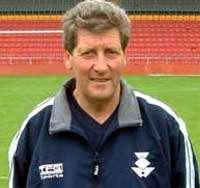
SPL guidelines at the time stipulated that clubs would only be eligible for promotion to the league if their stadium had a minimum 10,000 seated capacity. To comply with these guidelines the terraced section at the north end of Firhill was replaced with a 2000-seat stand. Speaking in 2004 Thistle chairman Tom Hughes argued the club did not at the time require a stadium with such a large capacity and building the new stand 'seriously affected [their] competitiveness'.[13] Thistle maintained their place in the SPL under Lambie by finishing 10th in 2002–03, despite being favourites for relegation.[14]
Successive relegations and play-off promotion
Following Lambie's retirement at the end of the 2002–03 season, Thistle struggled. Gerry Collins (Lambie's previous assistant) was sacked mid-season and replaced with joint player-managers Derek Whyte and Gerry Britton.[15] This change was not enough to revive the team, and Thistle were relegated at the end of the 2003–04 season after Inverness, having won the First Division title, were permitted to groundshare with Aberdeen. In season 2004–05 the team continued to struggle and Whyte and Britton were dismissed mid-season. Dick Campbell, their successor, was unable to avoid relegation to the Second Division. He did return the club to the First Division the following season, through the newly introduced play-off system, having finished 4th in the league. This brought to a close the club's most unpredictable decade, in footballing terms at least: between 1996 and 2006 Thistle had been promoted three times and relegated four times. They were the first team in Scottish football to be relegated from the top flight through successive subsequent relegations (excluding those caused by league reconstruction).[16]
Ian McCall's tenure, 2007–2011
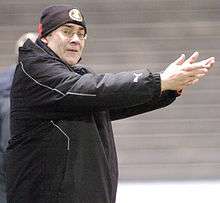
Despite starting well upon returning to the First Division, Dick Campbell was sacked on 27 March 2007,[17] following a succession of poor results.[18] A caretaker management team of Jimmy Bone and Terry Butcher saw out the season[19] before Ian McCall, a former player, was unveiled as manager. McCall's first season saw Thistle finish 6th in the First Division and embark on a successful Scottish Cup campaign, reaching the quarter-finals before being defeated by eventual winners Rangers after a 1–1 draw at Ibrox, Thistle lost the replay 2–0 at Firhill.[20] League form further improved in season 2008–09 with Thistle exceeding expectations to finish 2nd in the First Division, behind St Johnstone. This season saw midfielder Gary Harkins win the Irn Bru Phenomenal Player of the Year and Jonathan Tuffey become the club's first full international for several years.
McCall quit his post as manager in April 2011, citing personal reasons.[21] Jackie McNamara was initially appointed as caretaker manager[22] before being made full-time manager of the club at the end of the 2010–11 season.[23]
Jackie McNamara 2011–2013

McNamara and assistant Simon Donnelly guided Thistle to a sixth-place finish in 2011–12 season.[24] The following season Thistle started well and emerged as promotion candidates, competing with Dunfermline and Greenock Morton for a place in the following season's top flight. On 29 January 2013 the club gave permission to Dundee United to speak to McNamara about becoming their new manager.[25] The following day McNamara and his assistant Simon Donnelly resigned,[26] to become the new management team at United.[27][28] Along with Donnelly, McNamara brought goalkeeper Craig Hinchcliffe, Paul Paton and Chris Erskine to Tannadice. Thistle were second in the league at the time and, because McNamara was under contract, compensation was owed to the club.[29]
Alan Archibald (2013–present)
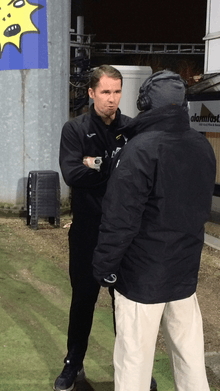
On 30 January 2013, Alan Archibald was appointed as the club's interim manager, with former Thistle player Scott Paterson as his assistant.[30] On 22 March, the duo were given the job on a permanent basis[31] signing a one-year rolling contract.[32] The following month on 20 April 2013, the club clinched promotion to the Scottish Premiership[33] having sealed the First Division championship with a 2–0 victory away to Falkirk.[34] The title win meant Thistle returned to the top flight of Scottish football for the first time in nine years.[35] Thistle's initial return to the Premiership had mixed success. The team managed to maintain a relatively positive away record, however it was months before Thistle finally secured a home win, with them beating Aberdeen 3–1 at Firhill in February 2014.[36] Thistle managed to avoid the relegation and play-off spots, eventually finishing third-bottom, following a 4–2 win away to Hearts at Tynecastle.[37]
The 2015–16 Scottish Premiership season saw Thistle secure long-term contracts for many of their key players, including Kris Doolan, Callum Booth, Tomáš Černý and Mustapha Dumbuya.
On 7 May 2016, Thistle secured their Premiership status with a 2-0 away victory to Kilmarnock, with goals coming from Steven Lawless and Kris Doolan. This result meant that Archibald overtook former manager Johnny Davidson as the record holder of top-flight victories.
Club crest and colours
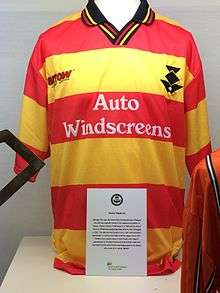
.svg.png)
The first crest to appear on a Partick Thistle kit was a thistle design, and every logo since has featured a thistle. The thistle appeared first in 1902, then again in 1909. It remained until 1978, when a new logo with the thistle housed inside a roundel was used. A modernist logo with the thistle on a rectangle was introduced in 1990, and the current crest was introduced in 2008.[38]
The Jags flirted with a number of colour schemes in their early years. From their inception until 1900 the kits were predominantly blue with red and white trimmings. There was then a brief period in which the players wore an orange and black striped top with white shorts and black socks. This was replaced in 1905 by a colour scheme close to that used by Aston Villa, before the club reverted to the predominantly blue kits in 1909. In season 1936–37 they changed to, and settled upon, the red-yellow-and-black attire for which they are best known, this change having been triggered initially by the club borrowing kits from the local rugby union team, West of Scotland Football Club.[39]
In 2008–09 and 2009–10, Thistle became the first football club in Scotland to use pink as the primary colour in their away kit. In 2008–09 this took the form of silver- and pink-hooped tops.
Since the 2013–14 season, Partick Thistle's kits have been manufactured by Joma Sports.[40] During the 2014–15 season, Partick Thistle supported the Breast Cancer Care Charity by wearing a black and pink away shirt, with the charity ribbon on the shirt. The partnership saw a portion of kit sale revenue being donated to Breast Cancer Care.[41] Partick Thistle's current home kit features a yellow and red shirt, the sleeves are yellow with a predominanty red foreground. The kit features black shorts, red socks, with a yellow trim. The away kit is white, with a yellow collar and sleeve trim on the jersey. Goalkeepers wear a generic kit design from Joma, and are either pink or grey.
Stadium
Before moving to the Maryhill area in 1909, Partick Thistle hosted their home games over numerous sites in and around Glasgow including Kelvingrove Park, Jordanvale Park and Muir Park. In 1891, the club moved to Meadowside, near the River Clyde. However, in 1908 Thistle were forced to vacate the area to make way for a new shipyard.
.jpg)
After playing at numerous other grounds in Glasgow, Greenock, Port Glasgow, Kilmarnock, Edinburgh and even Aberdeen for over a season,[42] Partick Thistle moved to their present home, Firhill Stadium, in 1909, when they purchased some spare Caledonian Railway land in Maryhill for £5,500.[43] The stadium consists of three stands: the Main Stand, where the away support is housed, which was built in 1927 and can seat around 2,900 supporters; the Jackie Husband Stand, which was built in 1994 and has a capacity of approximately 6,500; and the North Stand, which can house around 2,000 supporters. On the south side of the stadium there is a grass embankment, known to home fans as "The Bing", which had been open terracing until this was demolished in 2006 due to the stand failing to meet the criteria of Scottish Football Association safety regulations. There have been various plans to redevelop the south end of the stadium but thus far none have come to fruition.
Firhill has been used by other football teams and for rugby over the years. Between 1986 and 1991 Clyde ground shared with Thistle,[43] following their eviction from Shawfield.[44] Hamilton Academical also ground shared for two spells over seven years,[45] following them being forced out of Douglas Park in 1994. In December 2005, Firhill also became the home of Glasgow's professional rugby union team, Glasgow Warriors, when they moved from their previous base at Hughenden Stadium. After returning to Hughenden in 2006, the Warriors took up a two-year residency at Firhill from the start of the 2007–08 Celtic League season.[46] This was extended in April 2009 for a further five years.[47][48] Glasgow Warriors left Firhill after the 2011–12 season and moved to Scotstoun Stadium.[49][50] During the 2012–13 season the ground was also used by Celtic's under-20 squad as their home ground,[51] but following Partick's promotion this stopped for the 2013–14 season.[52]
During the 2013/14 season, the Main Stand was re-opened to seat the high number of away supporters. In one instance, the North Stand was used for Celtic supporters as fears grew over fire dangers. During early June 2016 the North Stand was renamed The Colin Weir Stand in honour of Colin Weir who was made the first ever patron of Partick Thistle after making numerous donations to the club's youth team The Thistle Weir Academy.
Maryhill railway station, which is served by trains from Glasgow Queen Street, is the closest railway station to Firhill.[53] The walk between the two sites takes between 20 and 25 minutes.[53] On the Glasgow Subway network, Kelvinbridge and St George's Cross are within 15 minutes walk of the stadium.[53] The A81 road (Maryhill Road), leading to Firhill Road, runs from the M8 motorway.[53]
The club train at the Garscube Sports Complex in Bearsden, East Dunbartonshire.[54]
Notable former players
All former players or managers listed have been inducted into either the Scottish Football Hall of Fame or Partick Thistle's own Hall of Fame. These include players who participated in both the 1921 Scottish Cup Final and the 1971 Scottish League Cup Final.[55][56]
Scottish Hall of Fame
Club Hall of Fame
|
Support
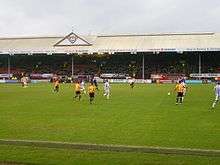
Club culture and fanbase
The club has a relatively modest fanbase which is mostly centred around Northern Glasgow, although they do have pockets of fans from across the globe.[57] Being in close proximity to a large student population the club attracts many new fans from the local universities.
The club prides itself on being non-sectarian[58] and, therefore, not involved in the Old Firm division.[57]
Hooliganism
Since the 1980s, the club has a small firm called the North Glasgow Express.[59]
Rivalries
Although the club competes with neighbours Rangers and Celtic, due to the vast differences in team size and fortunes those rivalries are not reciprocated. The "Glasgow derby" is therefore contested with Clyde F.C., sometimes dubbed the "Old Firm alternative".[60] One of the fiercest rivals are Airdrieonians with frequent violent clashes between fans.[61] Strong rivalries are also with Clydebank due to the geographic proximity and controversial ownership in the past with plans which almost saw both clubs bankrupt; and local rivals Kilmarnock.[62]
Chants
Thistle fans sing songs during matches, some of which are relatively generic but others which are unique. Choruses of "Rellow Army", "Mary fae Maryhill", "Over Land and Sea", "Forever and Ever", "We've Followed the Thistle for Many a Day", "Oh Maryhill is wonderful", "Do Do Do Conrad Balatoni" and "Gerry Britton is the King of Spain" are commonly heard in the singing section of the home support, in the North Stand or "New Shed".[63]
Attendances
During their previous foray into the top flight of Scottish football in season 2002–03 attendances exceeded 6,000, whereas in the lower divisions they have tended to range between 2,000 and 4,000.
During the jags title winning campaign a match of significant importance was played against Greenock Morton the attendance was 8,875 which was the highest first division attendance that season. [64]
On the day of their return to the top flight against Dundee United on 2 August 2013, the attendance at Firhill was 7,822.[65] Average home attendances for Thistle's maiden season back in the Scottish Premiership was around 5,000, however the 2014–15 season saw a 25% drop with an average home crowd of only 3,500.[66]
Sponsors
The club's main sponsor is Kingsford Capital Management, which was confirmed at the start of the 2015–16 season, taking over from beverage company MacB. The new sponsorship deal is thought to be worth around £200,000 for two years, which includes shirt, mascot and stadium sponsor.[67] Initially, MacB went into administration halfway through the season, and was replaced by legal company Just Employment Law for the remainder of the 2011–12 season.[68] MacB resumed sponsorship of Partick Thistle in the summer of 2012, and subsequently signed a two-year extension, keeping them as main sponsors until the end of the 2014–15 season. Scottish security system company Alarmfast also started sponsoring Thistle for the 2014–15 season. Thistle's mascot is a large yellow sun-like character called Kingsley, who replaced MacB's Jaggy MacBee at the start of Kingsford Capital's tenure.
Thistle's kit maker is Spanish manufacturers Joma, having replaced Puma Sports at the start of the 2013–14 season.[69]
| Kit suppliers | ||
|---|---|---|
| Dates | Supplier | |
| 1977–1983 | Umbro | |
| 1983–1984 | Unbranded | |
| 1984–1989 | Umbro | |
| 1989–1983 | Spall Sports | |
| 1993–1994 | Bukta | |
| 1994–1995 | Matchwinner | |
| 1995–1997 | Le Coq Sportif | |
| 1997–1999 | Arrow | |
| 1999–2000 | Rossco | |
| 2000–2002 | Secca Sports | |
| 2002–2006 | TFG Sports | |
| 2006–2008 | Diadora | |
| 2008–2013 | Puma | |
| 2013– | Joma | |
| Shirt sponsors[70] | |
|---|---|
| Dates | Sponsor |
| 1983–1986 | Morton Rolls |
| 1986–1987 | Ashoka West End |
| 1987–1989 | Colonel Gee's Carpets |
| 1989–1990 | Watson Towers |
| 1990–1996 | Texstyle World |
| 1996–1997 | DLS |
| 1997–1999 | Auto Windscreens |
| 1999–2007 | D.H.Morris Group |
| 2007–2008 | Resolution Asset Management |
| 2008–2011 | Ignis Asset Management |
| 2011–2012 | MacB Water |
| 2012 | Just Employment Law |
| 2012–2015 | MacB Water |
| 2015– | Kingsford Capital Management |
Mascot
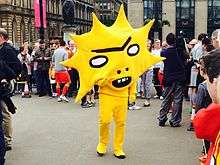
Partick Thistle's current mascot is named Kingsley, and was designed by the Turner Prize nominated artist David Shrigley. Kingsley was unveiled on 22 June 2015 to coincide with Thistle's new sponsorship with California-based investment firm Kingsford Capital Management. The mascot gained widespread notoriety online, having trended worldwide on Twitter, as well as being publicised by major networks such as CNN and The Washington Post.[71] Partick Thistle's general manager Ian Maxwell hailed the success of Kingsley in drawing attention to the club, stating that the worldwide interest and TV coverage amounted to the "biggest amount of publicity from a sponsorship launch in Scottish football history".[72] The Kingsley mascot has become a major source of merchandising potential for the club, with demand outstripping supply.[72]
Between 2011–2015, Thistle's mascot was Jaggy MacBee, a large bumble bee that had been introduced as part of the clubs sponsorship with MacB Water.[73] Before that, Thistle used a brightly coloured toucan called Pee Tee as its official mascot.[74]
Community trust
Partick Thistle Ladies
Following a successful set-up of women's football in Glasgow, with teams such as Celtic L.F.C. and Glasgow City, Partick Thistle entered a women's team into the 2013 Scottish Women's Football League Second Division season.[75]
The team train at the Firhill Complex in Maryhill.
Thistle Weir Youth Academy
In October 2013, millionaires and long time Thistle fans Chris and Colin Weir donated £750,000 to Partick Thistle to set up a new advanced youth academy. The academy was named the Thistle Weir Youth Academy and is run by former striker Gerry Britton.[76]
Current squad
First team squad
- As of 16 September 2016[77]
Note: Flags indicate national team as defined under FIFA eligibility rules. Players may hold more than one non-FIFA nationality.
|
|
Out on loan
Note: Flags indicate national team as defined under FIFA eligibility rules. Players may hold more than one non-FIFA nationality.
|
- For recent transfers, see List of Scottish football transfers summer 2016
Club staff
Managers
|
Boardroom
|
Other staff
|
Individual achievements
Most appearances
|
All-time top goalscorers
|
Honours
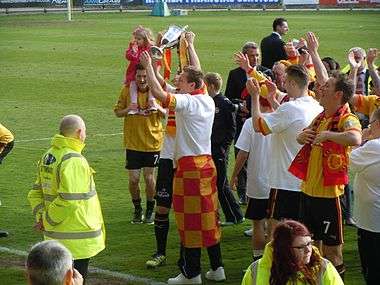
Major
Minor
- Scottish Football League First Division, second tier:[96]
- Scottish Football League Second Division, third tier:
- Scottish Challenge Cup:[97]
- Runners up (1): 2012–13
- Glasgow Cup:
- Winners (7): 1934–35, 1950–51, 1952–53, 1954–55, 1960–61, 1980–81, 1988–89
- Runners up (11) 1888–89, 1900–01, 1911–12, 1914–15, 1917–18, 1919–20, 1932–33, 1936–37, 1959–60, 1966–67, 1968–69
- British Cup:
- Winners (1): 1921
- Glasgow Merchants' Charity Cup:
- Winners (3): 1926–27, 1934–35, 1948–49
- Summer Cup:
- Winners (1): 1945
- West of Scotland FA Cup:
- Winners (1): 1879
- Glasgow Dental Cup:
- Winners (1): 1929
- Greenock Charity Cup:[98]
- Winners (1): 1893
- Paisley Charity Cup:
- Winners (1): 1936
- Yoker Cup:[99]
- Winners (3): 1881, 1882, 1883
- Arr Craib Trophy:[100]
- Winners (1): 2012
- Tennents' Sixes:[101]
- Winners (1): 1993 (final winners)
Club records
- Highest record home attendance: 49,838 vs Rangers, Scottish First Division, 18 February 1922[102]
- Most league appearances: Alan Rough, 410[102]
- Most league goals in a season: Alec Hair, 41, 1926–27[102]
- Record defeat: 0–10 v Queen's Park, Scottish Cup, 3 December 1881[102]
- Record victory: 16–0 v Royal Albert, Scottish Cup 1st round, 17 January 1931[102]
- Record points total: 78, Scottish First Division, 2012–13[102]
- Record transfer fee paid: £85,000 to Celtic for Andy Murdoch, February 1991[102]
- Record transfer fee received: £200,000 from Watford for Mo Johnston 1982[102]
European record
Thistle have participated in European competition on three different occasions. On the first occasion, they qualified having finished third in the First Division. They progressed to the second round of the Fairs Cup before being eliminated by Spartak Brno. They qualified for the UEFA Cup in 1972–73 after winning the League Cup the previous season; Hungarian side Honvéd eliminated them in the first round.[103] Their most recent European campaign was the 1995 UEFA Intertoto Cup, when they finished 4th with four points in Group 6.[104]
| Season | Competition | Round | Opponent | Home | Away | Aggregate |
|---|---|---|---|---|---|---|
| 1963–64 | Inter-Cities Fairs Cup | First round | 3–0 | 4–1 | 7–1 | |
| Second round | 3–2 | 0–4 | 3–6 | |||
| 1972–73 | UEFA Cup | First round | 0–3 | 0–1 | 0–4 | |
| 1995–96 | UEFA Intertoto Cup | Group 6 | – | 2–2 | – | |
| 3–1 | – | – | ||||
| – | 0–1[105] | – | ||||
| 1–2 | – | – |
References
- ↑ "Partick Thistle Football Club". Scottish Professional Football League. Retrieved 30 September 2013.
- ↑ Vassallo, Jean; Paul. "Partick Thistle Centenary Kits Launched". www.football-shirts.co.uk. Football Shirts News. Retrieved 8 November 2014.
- ↑ "1875–76 – Partick Thistle history – The Early Years". Ptearlyyears.net. Retrieved 30 July 2013.
- ↑ "Overnewton – Partick Thistle grounds – The Early Years". Ptearlyyears.net. Retrieved 30 July 2013.
- ↑ "Partick Thistle – Background". www.historicalkits.co.uk. Partick Thistle History Archive. Retrieved 8 November 2014.
- ↑ Kennedy, Neill. "Sam Kennedy 1902–1910". www.ptearlyyears.net. Neill Kennedy. Retrieved 6 November 2014.
- 1 2 "Club History – Partick Thistle Football Club". Ptfc.co.uk. Retrieved 30 July 2013.
- ↑ "Beware the Jags sting". BBC News. 21 March 2002. Retrieved 30 July 2013.
- ↑ "BBC SPORT | SCOTTISH CUP | Beware the Jags' sting". BBC News. 21 March 2002. Retrieved 30 July 2013.
- ↑ Philip, Robert (25 October 2006). "The day Hansen and Thistle were a thorn in Celtic's side". www.telegraph.co.uk. London: Telegraph Media Group. Retrieved 6 November 2014.
- ↑ Campsie, Alison. "Wealthy Jaggies inject £1m to cut Partick Thistle debt". www.heraldscotland.com. Newsquest. Retrieved 9 November 2014.
- ↑ McLean, Euan. "Partick Thistle captain Alan Archibald: Jags were first club to hit financial skids back in 1998.. we should have been the last". www.dailyrecord.co.uk. Trinity Mirror. Retrieved 6 November 2014.
- ↑ "Hughes Court Warning to SPL". BBC.co.uk/sport. BBC Sport. Retrieved 29 July 2013.
- ↑ "Scottish Premier League Archive 2002/2003". www.spfl.co.uk/archive/2002-2003. Scottish Professional Football League. Retrieved 6 November 2014.
- ↑ "Thistle sack boss Collins". www.news.bbc.co.uk. BBC. 30 November 2003. Retrieved 8 November 2014.
- ↑ Rogerson, Paul. "Partick Thistle posts loss after second successive relegation". www.heraldscotland.com. Herald & Times Group. Retrieved 6 November 2014.
- ↑ "Campbell axed by Partick Thistle". bbc.co.uk/sport. BBC Sport. 27 March 2007. Retrieved 27 July 2013.
- ↑ "Thistle axe Campbell as rising losses cause turmoil". scotsman.com. The Scotsman. 27 March 2007. Retrieved 27 July 2013.
- ↑ "Butcher takes Partick coach role". bbc.co.uk/sport. BBC Sport. 30 March 2007. Retrieved 27 July 2013.
- ↑ Moffat, Colin (13 April 2008). "Partick Thistle 0–2 Rangers". bbc.co.uk/sport. BBC Sport. Retrieved 9 August 2014.
- ↑ "Ian McCall quits as Partick Thistle manager". scotsman.com. The Scotsman. 15 April 2011. Retrieved 27 July 2013.
- ↑ "Ian McCall quits as Partick Thistle manager". bbc.co.uk/sport. BBC Sport. 15 April 2011. Retrieved 27 July 2013.
- ↑ "Jackie McNamara is appointed Partick Thistle manager". bbc.co.uk/sport. BBC Sport. 12 May 2011. Retrieved 27 July 2013.
- ↑ "2011/12 Scottish Division One Table / Table". ESPN Soccernet. ESPN. Retrieved 27 May 2012.
- ↑ "Statement From Partick Thistle". ptfc.co.uk. Partick Thistle F.C. 29 January 2013. Retrieved 30 January 2013.
- ↑ "Change in Management Team". ptfc.co.uk. Partick Thistle F.C. 30 January 2013. Retrieved 30 January 2013.
- ↑ "Jackie McNamara named as new Dundee United manager". bbc.co.uk/sport. BBC Sport. 30 January 2013. Retrieved 30 January 2013.
- ↑ "Jackie McNamara Announced As Manager". dundeeunitedfc.co.uk. Dundee United F.C. 30 January 2013. Retrieved 30 January 2013.
- ↑ "Compensation agreed as Partick end dispute over McNamara". heraldscotland.com. The Herald (Glasgow). 14 June 2013. Retrieved 27 July 2013.
- ↑ "Partick Thistle name player-coach Alan Archibald as interim boss". bbc.co.uk/sport. BBC Sport. 30 January 2013. Retrieved 30 January 2013.
- 1 2 "Alan Archibald – Confirmed as New Partick Thistle Manager". ptfc.co.uk. Partick Thistle F.C. 22 March 2013. Retrieved 22 March 2013.
- ↑ "Partick Thistle appoint Alan Archibald as manager at Firhill". bbc.co.uk. BBC Sport. 22 March 2013. Retrieved 22 March 2013.
- ↑ "Partick Thistle celebrate promotion to SPL". heraldscotland.com. The Herald (Glasgow). 21 April 2013. Retrieved 27 July 2013.
- ↑ "Thistle are champions". scottishfootballleague.com. Scottish Football League. 20 April 2013. Retrieved 27 July 2013.
- ↑ "Partick Thistle on SPL brink after nine-year exile". scotsman.com. The Scotsman. 16 April 2013. Retrieved 21 April 2013.
- ↑ Sutherland, Jonathan. "Partick Thistle earned their first home win of the season with a rousing performance against Aberdeen". www.bbc.co.uk/sport. BBC. Retrieved 7 November 2014.
- ↑ "Partick Thistle sealed their Premiership safety after producing a stunning second-half comeback to get the better of Hearts.". www.bbc.co.uk/sport. BBC. Retrieved 11 November 2014.
- ↑ Moor, Dave. "Partick Thistle". Historical Football Kits. Retrieved 18 October 2012.
- ↑ "Partick Thistle – Historical Football Kits". www.historicalkits.co.uk. Retrieved 8 March 2015.
- ↑ Partick Thistle FC. "Joma Have Arrived". Partick Thistle FC.
- ↑ "Partick Thistle unveil breast cancer away strip".
- ↑ Paul Smith & Shirley Smith (2005) The Ultimate Directory of English & Scottish Football League Grounds Second Edition 1888–2005, Yore Publications, p197 ISBN 0954783042
- 1 2 Inglis 1996, p. 459
- ↑ "Clyde fans set to vote on relocation". scotsman.com. The Scotsman. 19 April 2013. Retrieved 27 July 2013.
- ↑ "Club History". hamiltonadvertiser.co.uk. Hamilton Advertiser. Retrieved 27 July 2013.
- ↑ "Firhill pitch can cope with rugby, insists chairman". www.stv.tv. STV. Archived from the original on 30 September 2007. Retrieved 8 October 2013.
- ↑ Rumsby, Ben. "Glasgow to stay at Firhill for next five years – Scotsman.com Sport". Sport.scotsman.com. Retrieved 19 June 2010.
- ↑ "Warriors look to create fortress at Firhill". Magners League Official Website.
- ↑ "STATEMENT FROM GLASGOW WARRIORS AND SCOTTISH RUGBY ON SCOTSTOUN STADIUM". www.glasgowwarriors.org. Glasgow Warriors. 30 September 2011. Retrieved 14 July 2012.
- ↑ Reid, Alasdair (28 June 2012). "Early season-ticket sales rise 500% as Glasgow settle in at Scotstoun". The Herald. Herald & Times Group. Retrieved 14 July 2012.
- ↑ "Celts deal a lifeline for Jags' NextGen". eveningtimes.co.uk. Evening Times. 23 August 2013. Retrieved 27 July 2013.
- ↑ "Pitch Update". ptfc.co.uk. Partick Thistle. 14 May 2013. Retrieved 27 July 2013.
- 1 2 3 4 "Partick Thistle". Scottish Football Ground Guide. Retrieved 14 July 2012.
- ↑ "New training ground will help Partick attract new players, says Jags boss Alan Archibald". dailyrecord.co.uk. Daily Record. 2 June 2014. Retrieved 22 October 2014.
- ↑ "Hall of Fame". www.ptfc.co.uk. Partick Thistle F.C. Retrieved 10 November 2014.
- ↑ "Hall of Fame inductee". www.ptfc.co.uk. Partick Thistle F.C. Retrieved 10 November 2014.
- 1 2 McGrath, Harry (20 January 2015). "Meet the Partick Thistle fans who support their team from across the globe".
- ↑ Geopolitics: Re-Visioning World Politics by John Agnew, Routledge, 1 Mar 2004
- ↑ Celtic Soccer Crew: What the Hell Do We Care? by John O'Kane, 19 April 2012, John Blake Publishing, Chapter: Other firms
- ↑ Brockett, David (2 August 2016). "The ones to watch as Clyde take on Partick Thistle in the Irn Bru Cup".
- ↑ Administrator, dailyrecord (8 May 2009). "Man seriously hurt in street battle between Partick Thistle and Airdrie United fans".
- ↑ Fyfe, Chris. "When Saturday Comes - Partick Thistle".
- ↑ "Standing Room Only – Partick Thistle Football Club". Ptfc.co.uk. Retrieved 30 July 2013.
- ↑ http://www.bbc.co.uk/sport/football/22057991
- ↑ "Partick Thistle v Dundee United, 2nd August 2013". www.ptfc.co.uk. Partick Thistle F.C. Retrieved 11 November 2014.
- ↑ "How Has Your Club's Average Attendances Changed in the Past 20 Years". Stv.co.uk. Retrieved 4 December 2014.
- ↑ "MacB: Partick Thistle". www.macb.co.uk. MacB Water. Retrieved 11 November 2014.
- ↑ "New Sponsor Photos". www.ptfc.co.uk. Partick Thistle F.C. Retrieved 11 November 2014.
- ↑ "Joma Have Arrived at Firhill". www.ptfc.co.uk. Partick Thistle Football Club. Retrieved 5 November 2014.
- ↑ "Partick Thistle". Historical Football Kits. Retrieved 11 January 2016.
- ↑ Bonesteel, Matt (22 June 2015). "Partick Thistle FC's new mascot will haunt your dreams". The Washington Post.
- 1 2 Parks, Gordon (27 June 2015). "Partick Thistle's new mascot Kingsley proves fans want change in Scottish football, says Firhill general manager Ian Maxwell". Daily Record. Retrieved 11 January 2016.
- ↑ "Macb water sponsors Patrick Thistle football club". Talking Retail. 16 June 2011. Retrieved 11 January 2016.
- ↑ Sutherland, Gary (2012-08-10). Hunting Grounds: A Scottish Football Safari. Birlinn. ISBN 9780857901187.
- ↑ Lach, Stef. "Thistle be great for women's football". www.eveningtimes.co.uk. Herald and Times. O Azerbaijan Group. Retrieved 6 November 2014.
- ↑ "Thistle Weir Youth Academy Update". www.ptfc.co.uk. Partick Thistle F.C. Retrieved 12 November 2014.
- ↑ "Partick Thistle: Players". www.ptfc.co.uk. Partick Thistle F.C. Retrieved 6 January 2015.
- ↑ "Abdul Osman believes Partick Thistle can kick on into top six". www.heraldscotland.com. Herald Scotland. Retrieved 1 August 2015.
- ↑ "Timeline of Managers". fitbastats.com. Fitba Stats. Retrieved 29 July 2013.
- ↑ "Robert Reid: Honorary Vice President". ptfc.co.uk. Partick Thistle F.C. 26 July 2012. Retrieved 26 July 2014.
- ↑ "Partick Thistle supporters were a lifesaver". dailyrecord.co.uk. Daily Record (Scotland). 22 June 2013. Retrieved 27 July 2013.
- ↑ "Ian Maxwell: Managing Director". ptfc.co.uk. Partick Thistle F.C. Retrieved 27 July 2013.
- ↑ "Billy Allan". ptfc.co.uk. Partick Thistle F.C. Retrieved 27 July 2013.
- ↑ "Greig Brown". ptfc.co.uk. Partick Thistle F.C. Retrieved 27 July 2013.
- ↑ "Chopra takes seat at Jags' top table". eveningtimes.co.uk. Evening Times. 5 June 2012. Retrieved 27 July 2013.
- ↑ "Ian Dodd". ptfc.co.uk. Partick Thistle F.C. Retrieved 27 July 2013.
- ↑ "Brian Donald". ptfc.co.uk. Partick Thistle F.C. Retrieved 27 July 2013.
- ↑ "Gerry Britton". ptfc.co.uk. Partick Thistle F.C. Retrieved 27 July 2013.
- ↑ "Dr Allan Robertson: Honorary Medical Officer". ptfc.co.uk. Partick Thistle F.C. Retrieved 27 July 2013.
- ↑ "Meet Partick Thistle's new Physio". www.ptfc.co.uk. Partick Thistle F.C. Retrieved 11 November 2014.
- ↑ "Thistle's development squad back in action". www.ptfc.co.uk. Partick Thistle F.C. Retrieved 11 November 2014.
- ↑ "Paul Gallacher: Goalkeeper". www.ptfc.co.uk. Partick Thistle. Retrieved 11 November 2014.
- ↑ "Media Team scoop prestigious award".
- ↑ "Alan Archibald". www.soccerbase.com. Soccer Base. Retrieved 11 November 2014.
- ↑ "Fifth Hall of Fame Inductee". www.ptfc.co.uk. Partick Thistle. Retrieved 17 November 2014.
- ↑ Known as second division prior to 1975
- ↑ Miller, Stevie. "Queen of the South lifted the Challenge Cup for the second time after a penalty shoot-out victory over Partick Thistle". www.bbc.co.uk/sport. BBC. Retrieved 17 November 2014.
- ↑ "Greenock Charity Cup 1884–1896". Scottish-football-historical-archive.com. Retrieved 30 July 2013.
- ↑ "Yoker Cup 1880–1883". Scottish-football-historical-archive.com. Retrieved 30 July 2013.
- ↑ "ARR Craib Trophy: Sean Welsh steals the show as Partick Thistle dump Everton to lift cup". 23 July 2012. Retrieved 24 July 2012.
- ↑ Bathgate, Stuart. "When winters were warmed by six appeal". www.scotsman.com. The Scotsman. Retrieved 17 November 2014.
- 1 2 3 4 5 6 7 8 "Club Records". ptfc.co.uk. Partick Thistle F.C. Retrieved 30 July 2013.
- ↑ Kennedy, Niall. "Partick Thistle-Club History". www.ptfc.co.uk. Partick Thistle Football Club. Retrieved 5 November 2014.
- ↑ "UEFA history – Partick Thistle". www.uefa.com. UEFA. Retrieved 9 November 2014.
- ↑ Angulo, Rodrigo (14 October 2007). "European Football Database". www.footballdatabase.eu. FootballDatabase.eu. Retrieved 5 November 2014.
- Sources
- Inglis, Simon (1996). Football Grounds of Britain. Collins Willow. ISBN 0-00-218426-5.
External links
| Wikimedia Commons has media related to Partick Thistle FC. |
